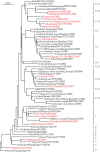Avian influenza virus, Streptococcus suis serotype 2, severe acute respiratory syndrome-coronavirus and beyond: molecular epidemiology, ecology and the situation in China
- PMID: 19687041
- PMCID: PMC2865088
- DOI: 10.1098/rstb.2009.0093
Avian influenza virus, Streptococcus suis serotype 2, severe acute respiratory syndrome-coronavirus and beyond: molecular epidemiology, ecology and the situation in China
Abstract
The outbreak and spread of severe acute respiratory syndrome-associated coronavirus and the subsequent identification of its animal origin study have heightened the world's awareness of animal-borne or zoonotic pathogens. In addition to SARS, the highly pathogenic avian influenza virus (AIV), H5N1, and the lower pathogenicity H9N2 AIV have expanded their host ranges to infect human beings and other mammalian species as well as birds. Even the 'well-known' reservoir animals for influenza virus, migratory birds, became victims of the highly pathogenic H5N1 virus. Not only the viruses, but bacteria can also expand their host range: a new disease, streptococcal toxic shock syndrome, caused by human Streptococcus suis serotype 2 infection, has been observed in China with 52 human fatalities in two separate outbreaks (1998 and 2005, respectively). Additionally, enterohaemorrhagic Escherichia coli O157:H7 infection has increased worldwide with severe disease. Several outbreaks and sporadic isolations of this pathogen in China have made it an important target for disease control. A new highly pathogenic variant of porcine reproductive and respiratory syndrome virus (PRRSV) has been isolated in both China and Vietnam recently; although PRRSV is not a zoonotic human pathogen, its severe outbreaks have implications for food safety. All of these pathogens occur in Southeast Asia, including China, with severe consequences; therefore, we discuss the issues in this article by addressing the situation of the zoonotic threat in China.
Figures





References
-
- An T. Q., Zhou Y. J., Liu G. Q., Tian Z. J., Li J., Qiu H. J., Tong G. Z. 2007. Genetic diversity and phylogenetic analysis of glycoprotein 5 of PRRSV isolates in Mainland China from 1996 to 2006: coexistence of two NA-subgenotypes with great diversity. Vet. Microbiol. 123, 43–52. (10.1016/j.vetmic.2007.02.025) - DOI - PubMed
Publication types
MeSH terms
Grants and funding
LinkOut - more resources
Full Text Sources
Medical
Miscellaneous

